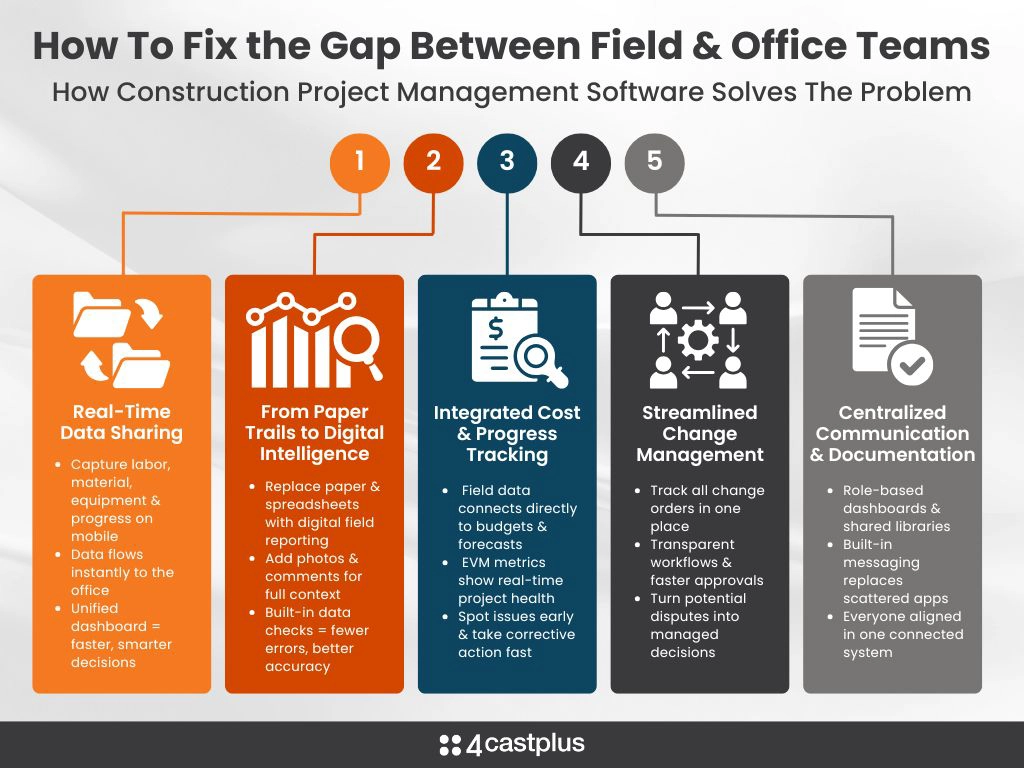Read In 13 Minutes
Why Field–Office Alignment Is Critical In Construction
In today’s construction landscape, collaboration isn’t just beneficial—it’s essential. As projects grow in scale and complexity, success hinges on seamless coordination between multiple teams, subcontractors, and stakeholders. Yet when field crews and office teams operate in silos, the fallout is costly: budget overruns, schedule delays, communication breakdowns, and ultimately, diminished profitability.

The Disconnect Challenge
Field and office teams inhabit fundamentally different operational environments. On-site crews navigate dynamic, fast-moving conditions, shifting priorities, risk and safety. Meanwhile, office teams focus on the bigger picture—managing budgets and schedules, ensuring compliance, analyzing forecasts, and reporting to the client. Each team fulfills a critical role, and the efficiency of their interdependent relationship is key for overall productivity. Project success depends on both field and office having access to accurate, up-to-the-minute information from each other.
Disconnected spreadsheets and fragmented systems are what create information bottlenecks that prevent real-time collaboration between field and office. Critical data gets trapped in silos, leaving teams to make decisions based on incomplete or outdated information.
The Solution: Unified Project Management
Modern construction project management software eliminates these barriers by creating a single source of truth that is accessed by all teams through a common platform everyone uses. When field and office teams share real-time access to project data, communication flows seamlessly, informed decisions are made faster, and projects stay on track. “Poor communication” is often cited as a primary reason projects experience budget overruns and fail to meet their obligations. McKinsey, for example, has published various reports analyzing construction project success, such as this report on “Reinventing Construction through a productivity revolution.” In that report, they state, “Too often, poor communication, a lack of sufficient and deliberate front-end loading, and low adherence to collaborative planning processes lead to high levels of change orders during the life cycle of projects. This drags down productivity by forcing work stoppages, necessitating rework, and disrupting flows of materials and labor. [p. 54]”
Learn More About Construction Management
Why Field–Office Collaboration Matters
Every construction project relies on the continuous exchange of critical data:
- Field to Office: Progress updates, labor hours, costs, billings, expenses, material usage, equipment tracking, RFIs, and change orders.
- Office to Field: Updated schedules, approved budgets, drawings, and compliance documents.
When this exchange breaks down, mistakes happen:
- Cost and schedule overruns go unnoticed until it’s too late
- Forecasts are based on incomplete data
- Cash flow planning becomes guesswork
- Change orders slip through the cracks
These issues don’t just cause financial headaches—they can damage client relationships and stakeholder trust. Improving collaboration between field and office is, put simply, vital to keeping projects on track and protecting profit margins.
Challenges of Traditional Communication
Historically, collaboration has been managed through:
- Paper forms passed from site to office
- Excel spreadsheets manually updated and emailed around
- Phone calls and text messages for urgent updates
While these methods may feel familiar, they are slow, very manual, prone to errors & omissions, and require rekeying the information into multiple systems. Additionally, by the time office teams receive and process field data, not only is it often outdated—leading to reactive decision-making rather than proactive planning – it has not gone through data validation checks to ensure accuracy and completeness. This leads to a behavior of throwing the problems over the fence for someone else to fix.
How Construction Project Management Software Solves The Problem
Modern construction project management platforms bring the field and office together on one connected system. Here’s how:

1. Real-Time Data Sharing
With cloud-based project management software, field teams can instantly capture and upload critical project data—labor hours, material costs, equipment usage, and progress updates—directly from their mobile devices. This information flows immediately to office teams, eliminating the bottlenecks and errors inherent in manual data entry and paper-based reporting.
The Result: Teams across your organization operate from a unified, real-time dashboard. This shared visibility eliminates miscommunication, accelerates decision-making, and ensures everyone has access to the most current project information when they need it most.
2. From Paper Trails to Digital Intelligence
Digital field reporting revolutionizes how crews document and communicate project activities. Field teams can seamlessly capture comprehensive project data, including labor, equipment, and materials usage, while adding visual context through integrated photo attachments. When issues arise, crews can immediately flag concerns and provide detailed comments, creating a rich, contextual record of field conditions.
Every entry syncs instantly across the platform, ensuring project managers and finance teams have immediate access to accurate, up-to-date information without waiting for end-of-day reports or manual data transfers.
The system is preconfigured to perform data integrity checks at the point of entry to eliminate common errors, omissions, and to adhere to best practices defined by the company.
The Impact: This shift from reactive to proactive reporting delivers measurable improvements in data accuracy, team accountability, and operational efficiency—while freeing up valuable time previously lost to administrative tasks.
3. Integrated Cost & Progress Tracking
Every field activity carries financial implications that must align with project budgets to ensure profitability. When construction software seamlessly integrates real-time field inputs with financial systems, project teams gain powerful analytical capabilities through Earned Value Management (EVM) metrics. This integration enables continuous comparison of actual costs against planned budgets and earned value, creating a comprehensive view of project financial health.
The Advantage: Project managers can identify budget variances the moment they occur, enabling immediate corrective action before minor issues become major cost overruns. This proactive approach transforms financial management from reactive damage control into strategic project optimization.
4. Streamlined Change Management
Change orders are a construction reality, but they don’t have to derail projects or relationships. Poor communication around modifications often transforms routine adjustments into costly claims, disputes and budget disasters. Modern project management software eliminates this chaos by creating a comprehensive digital trail that captures every change request, tracks approval workflows, and cost implications in a centralized hub accessible to all stakeholders.
Transformation: This systematic approach replaces confusion with clarity, delivering complete transparency throughout the change process. Approvals move faster, costs stay controlled, and teams maintain alignment even as project scope evolves—turning potential project disruptors into manageable business decisions.
5. Centralized Communication & Documentation
Today’s construction management platforms create a unified collaboration ecosystem where every team member has the tools they need at their fingertips. Role-based dashboards ensure each user sees the most relevant information for their responsibilities, while shared document libraries maintain version control and universal access to critical project files. Integrated messaging eliminates the chaos of juggling multiple communication apps, email chains, and phone calls.
The Result: Teams operate within a single, cohesive digital environment that eliminates the friction of switching between platforms. This streamlined approach accelerates decision-making, reduces miscommunication, and ensures nothing falls through the cracks when coordinating between field and office operations.
The Business Impact of Strong Collaboration
When the field and office are aligned, the benefits go beyond smoother communication:
- Reduced Risk: Early detection of issues prevents major overruns.
- Higher Productivity: Less time spent chasing updates means more time spent executing.
- Better Financial Control: Accurate forecasts and cost tracking support profitability.
- Improved Client Confidence: Transparent, timely reporting builds trust with stakeholders.
How 4castplus Helps Bridge the Gap
4castplus is built to eliminate the disconnect between the jobsite and the office, offering tools that make construction collaboration effortless:
- Mobile Field Tracking: Crews can log labor, equipment, material, and progress usage on-site using any mobile device.
- Digital Daily Field Reports: Submit daily field reports (field ticket, LEM, docket) with photos and notes directly from the field.
- Integrated Cost Control: Field data instantly updates budgets, forecasts, dashboards and reports, giving office teams real-time visibility.
- Built-In Change Management: Track and approve change orders within the platform to maintain control over scope and cost.
- Live Dashboards & Reporting: Real-time analytics help project managers make informed decisions faster.
With 4castplus, you’re not just managing projects—you’re creating a connected environment where field and office teams collaborate seamlessly.
Final Thoughts
Construction collaboration isn’t optional—it’s essential for keeping projects on time and on budget. By replacing outdated processes with an integrated project management solution like 4castplus, you can eliminate data silos, improve efficiency, and empower your teams to work as one cohesive unit.
Learn More
Want to see how 4castplus can help your teams work smarter together? From real-time field reporting to integrated cost control and streamlined change management, 4castplus connects every part of your project in one platform. Explore how our solution improves collaboration, boosts profitability, and gives you the visibility to keep projects on track—schedule a demo or learn more today.
 Platform
Platform Solutions
Solutions Owners
Owners Contractors
Contractors Engineering/EPCM
Engineering/EPCM Professional Services
Professional Services Resources
Resources White Papers
White Papers Case Studies
Case Studies Blog
Blog Videos
Videos Frequently Asked Questions
Frequently Asked Questions Company
Company About
About

